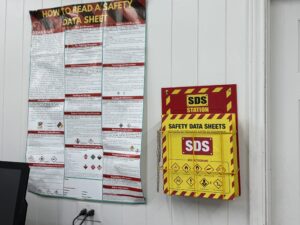We also offer
What Is a Process Safety Management (PSM) Gap Analysis?
A Process Safety Management (PSM) Gap Analysis is a structured evaluation that helps industrial facilities assess the effectiveness of their existing PSM programs. It identifies areas where current practices fall short of OSHA’s PSM standard (29 CFR 1910.119) and industry best practices, such as those outlined by the Center for Chemical Process Safety (CCPS).
This assessment is a vital step in proactively managing safety risks related to hazardous chemicals and complex processes. By comparing your current process safety systems to regulatory requirements and risk-based safety frameworks, a PSM Gap Analysis uncovers compliance gaps, operational weaknesses, and areas for improvement.
Why Conduct a Process Safety Management (PSM) Gap Analysis?
Performing a PSM Gap Analysis allows your facility to:
-
Identify non-compliance with OSHA and other regulatory standards
-
Benchmark your safety program against industry-leading practices
-
Detect and mitigate process safety risks before incidents occur
-
Improve your safety culture and employee awareness
-
Enhance operational reliability and reduce unplanned downtime
-
Avoid fines, enforcement actions, and reputational damage
-
Establish a roadmap for continuous safety improvement
Whether you’re preparing for an audit, undergoing a management system upgrade, or aiming to improve internal performance, a PSM gap analysis provides a clear snapshot of your current status and what steps are needed to close the gaps.
What Does a Process Safety Management (PSM) Gap Analysis Involve?
At Prime Process Safety Center, we follow a systematic process based on CCPS Guidelines for Risk-Based Process Safety and OSHA PSM requirements. Our analysis includes the following steps:
1. Review of Current PSM Practices
We evaluate all components of your PSM program, including:
-
Operating procedures
-
Mechanical integrity
-
Training and emergency planning
-
Management of Change (MOC)
2. Regulatory Comparison
Your current practices are measured against OSHA’s 29 CFR 1910.119 and other applicable U.S. or international safety standards.
3. Benchmarking Against Industry Best Practices
We compare your systems to industry leaders to highlight missed opportunities for improvement.
4. Gap Identification
We pinpoint gaps in compliance, documentation, procedures, and safety culture.
5. Risk Assessment
Each gap is assessed based on its potential risk impact, helping prioritize corrective actions.
6. Actionable Recommendations
We provide clear, practical steps to close each gap—from equipment upgrades to procedural changes and training enhancements.
7. Action Plan Development
We help you create a step-by-step action plan that includes timelines, assigned responsibilities, and resource estimates.
8. Implementation Support and Follow-Up
We offer ongoing support to implement changes and ensure long-term compliance and safety improvements.
Our Framework: CCPS Risk-Based Process Safety Pillars
Our gap analysis is built around the four pillars of Risk-Based Process Safety from the CCPS:
1. Commit to Process Safety
-
Safety culture
-
Compliance with regulations
-
Process safety competency
-
Workforce involvement
-
Stakeholder outreach
2. Understand Hazards and Risks
3. Manage Risk
-
Operating procedures and safe work practices
-
Mechanical integrity and asset reliability
-
Contractor safety
-
Training and performance
-
Management of Change (MOC)
-
Emergency preparedness
-
Incident investigation
-
Hot work permitting
-
Operational readiness
4. Learn from Experience
-
Auditing and performance metrics
-
Management review and continuous improvement
Why Choose Prime Process Safety Center
At Prime Process Safety Center, we specialize in helping facilities identify and close gaps in their PSM programs. Here’s what sets us apart:
-
Deep Process Safety Expertise: Decades of hands-on experience in PSM and OSHA compliance.
-
Customized Gap Assessments: Tailored evaluations based on your industry, facility design, and operations.
-
Regulatory Alignment: We ensure compliance with OSHA, EPA, CCPS, and industry-specific regulations.
-
Practical, Actionable Insights: Recommendations you can actually implement—with clarity and measurable results.
-
Risk-Based Prioritization: Focus on high-impact gaps that matter most for safety and performance.
-
Training and Support: On-site education and workshops to strengthen your team’s safety capabilities.
-
Ongoing Partnership: We work with you long-term to monitor progress, adapt to changes, and maintain compliance.
FAQ
1. What is Process Safety Management (PSM) Gap Analysis?
PSM Gap Analysis is a systematic review to identify and assess discrepancies between current process safety practices and the ideal or required standards in an industrial setting.
2. Why is PSM Gap Analysis important?
It's crucial for ensuring compliance with regulatory standards, identifying areas of potential risk, and improving overall safety in facilities handling hazardous chemicals or processes.
3. What does PSM Gap Analysis typically assess?
It evaluates key elements of PSM like safety culture, risk management practices, operating procedures, equipment integrity, and emergency response plans against established benchmarks.
4. Who should perform PSM Gap Analysis?
Qualified professionals with expertise in process safety, regulatory compliance, and industrial operations should conduct these analyses.
5. How often should PSM Gap Analysis be conducted?
Regular analyses are recommended, especially when there are changes in processes, equipment, regulations, or after an incident.
6. What are the outcomes of a PSM Gap Analysis?
The outcomes include a detailed report highlighting areas of non-compliance, potential risks, and recommendations for improvements.
7. How does PSM Gap Analysis contribute to operational efficiency?
By identifying and addressing gaps, it can lead to more streamlined and safer operations, reducing the likelihood of accidents and improving productivity.
8. What regulatory standards are referenced in PSM Gap Analysis?
It typically references standards like OSHA’s Process Safety Management regulations, EPA’s Risk Management Program requirements, and industry best practices.
9. Can PSM Gap Analysis help in incident investigation?
Yes, by identifying systemic weaknesses, it can provide insights into underlying causes of incidents, aiding in thorough investigations.
10. What's the difference between PSM Gap Analysis and a PSM Audit?
A PSM Audit is more comprehensive and formal, often required by regulations, while a PSM Gap Analysis is a proactive approach to identify and address potential weaknesses in process safety management.














